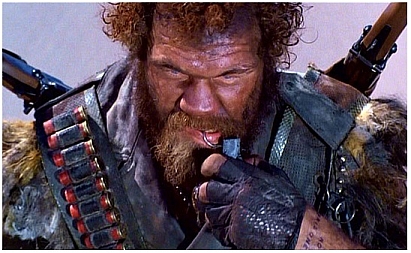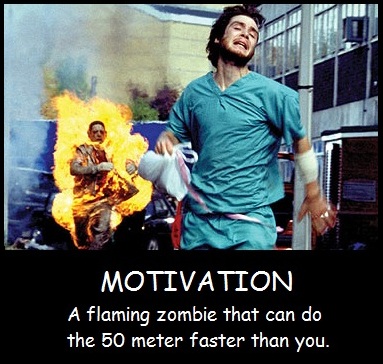“You want to find an outlaw, hire an outlaw.”
 “Name’s Smalls. Leonard Smalls. My friends call me Lenny…only I ain’t got no friends.”
“Name’s Smalls. Leonard Smalls. My friends call me Lenny…only I ain’t got no friends.”
Leonard Smalls is an outlaw bounty hunter from another dimension. He claims to have arrived in this dimension after being “exploded” in a fight over a kidnapped infant. Somehow, the explosion ripped a hole in the fabric of reality, and Leonard was sucked through. He has since honed his skills as a manhunter and criminal, adapting well to his new world. Leonard specializes in hunting bounties, killing animals (the smaller and cuter the better), and trafficking in human misery.
N.B. Leonard treats all firearms as martial weapons.
The Warthog from Hell
CR 9; XP 6,400
Advanced fiendish human ranger (trapper|trophy hunter) 5/alchemist 2
CE Medium humanoid
Init +2; Senses darkvision 60 ft., Perception +13 (+15 to find traps)
DEFENSE
AC 22, touch 14, flat-footed 18 (+6 armor, +2 deflection, +2 Dex, +2 natural)
hp 81 (5d10+30 plus 2d8+10)
Fort +12, Ref +9, Will +6; +2 vs. poison
Defensive Ability gunslinger’s dodge; DR 5/good; Resist cold 10, fire 10; SR 13
OFFENSE
Speed 40 ft. (30 ft. without boots of striding and springing)
Melee +1 heavy flail +11/+6 (1d10+7/19-20) (+2 disarm with flail), or
Ranged bomb +9 touch (1d6+3 fire, range 20 feet), or
Ranged masterwork double-barreled pistol +9/+4 (1d8+1/x4, 20 ft. range increment)
Special Attacks explosive bomb (1d6+3 fire, 4 points splash, Ref 14, 5/day), favored enemy (animal) +2, favored enemy (human) +4
Extracts Known (CL 2nd, concentration +5)
1st (3/day) – disguise self, jump, longshot, see alignment, shield, stone fist
STATISTICS
Str 18, Dex 14, Con 21, Int 17, Wis 16, Cha 13
Base Atk +6; CMB +10 (+12 dirty trick & disarm); CMD 22 (24 vs. dirty trick & disarm)
Feats Amateur Gunslinger (B), Brew Potion (B), Combat Expertise, Endurance (B), Gunsmithing, Improved Dirty Trick, Improved Disarm, Iron Will (B), No Name (B), Throw Anything (B)
Skills Acrobatics +0 (+7 jumping), Bluff +10*, Climb +7, Craft (alchemy) +15, Disable Device +7, Intimidate +11, Knowledge (geography) +11*, Knowledge (local) +8*, Knowledge (nature) +13*, Perception +13* (+15 to find traps), Sense Motive +11*, Sleight of Hand +5, Stealth +8*, Survival +13* (+15 to follow or identify tracks), Swim +7; Armor Check -2; N.B. Skills marked with an asterisk can be modified by favored enemy and/or favored terrain.
Languages Abyssal, Common, Giant, Goblin, Spanish
SQ alchemy +2, favored terrain (desert) +2, grit (up to 3), mutagen, poison use, track +2, trapfinding +2
SPECIAL ABILITIES
Class Skills: Leonard adds Disable Device to his list of class skills in addition to the normal ranger class skills.
Explosive Bomb: Leonard’s bombs have a splash radius of 10 feet rather than 5 feet. Creatures that take a direct hit from an explosive bomb catch fire, taking 1d6 points of fire damage each round until the fire is extinguished. Extinguishing the flames is a full-round action that requires a Reflex save. Rolling on the ground provides the target with a +2 to the save. Dousing the target with at least 2 gallons of water automatically extinguishes the flames.
Firearm Style: Leonard gains the Amateur Gunslinger feat gains a 1st-level Gunslinger deed. At every four levels after 1st, he can take a grit feat or select a Gunslinger deed of his level or lower, his choice.
Gunslinger’s Dodge (Ex): Leonard has an uncanny knack for getting out of the way of ranged attacks. When a ranged attack is made against him, he can spend 1 grit point to move 5 feet as an immediate action; doing so grants Leonard a +2 bonus to AC against the triggering attack. This movement is not a 5-foot step, and provokes attacks of opportunity. Alternatively, Leonard can drop prone to gain a +4 bonus to AC against the triggering attack. He can only perform this deed while wearing medium or light armor, and while carrying no more than a light load.
Hunter’s Aim (Ex): Leonard has a specific understanding of the weaknesses and vulnerabilities of his favored enemies, and his careful study of these enemies reveals the best way to hurt them. When Leonard makes a firearm attack against a favored enemy, he can target touch AC in the first two range increments of his firearm. This ability stacks with other effects that increase the range increments to target touch AC, adding one range increment to the effect.
Improved Tracking (Ex): Leonard gains a +2 bonus on Survival skill checks when following or identifying tracks. When he tracks, he can also attempt a Knowledge (nature) check at DC 15. On a success, Leonard can discern the type and condition of any animals or magical beasts he tracks. By studying their tracks, Leonard is able to identify a rough approximation of their health, maneuverability, and their general behavior as compared to the norm.
Smite Good (Su): Once per day, Leonard may smite a good-aligned creature. As a swift action, Leonard chooses one target within sight to smite. If this target is good, Leonard adds his Charisma bonus (+1) to attack rolls and gains a +7 damage bonus against that foe. This effect persists until the target is dead or the creature rests.
Ranger Traps: Leonard knows how to create a snare trap and swarm trap. He can use these traps a total 5 times per day.
Trapfinding: Leonard adds 1/2 his ranger level on Perception skill checks made to locate traps and on Disable Device skill checks. He can use Disable Device to disarm magic traps.
GEAR
+1 heavy flail, +1 bullet (x20), +2 hide shirt, boots of striding and springing, gloves of swimming and climbing, ring of protection +2, masterwork double-barreled pistol (x2), black powder (20 doses), formula book, gunsmith’s kit, powder horn (x2), plus 814 gp
N.B. Leonard has equipment equal to a PC of his level instead of NPC-equivalent equipment. This bumps his CR by +1 (included above).
 My son Giant Boy and I watched
My son Giant Boy and I watched 
 The methoataske is a truly enormous ambush predator, very much resembling an alligator snapping turtle larger than a house. It tends to strike from camouflage, lunging forward to swallow its prey whole. If harrassed after gulping down a victim, a methoataske is likely to retreat to deeper water.
The methoataske is a truly enormous ambush predator, very much resembling an alligator snapping turtle larger than a house. It tends to strike from camouflage, lunging forward to swallow its prey whole. If harrassed after gulping down a victim, a methoataske is likely to retreat to deeper water.